DevOps Branching Strategies Explained


Branching strategies contribute to setting up or managing a productive DevOps team that can reliably produce quality code. Branching strategy best practices will help you deliver code faster, with fewer issues, and give you the ability to scale as your teams grow.
Version control is one of the primary components of the DevOps pipeline. It effectively allows the following:
However, if code repositories are not managed properly, they can quickly become bloated and unwieldy, defeating the essential purpose of source control. One of the best ways to keep everything organized is by adhering to DevOps branching strategy best practices for all your development needs.
In this article, we will discuss different branching strategies that can be used to streamline your development experience.
(This article is part of our DevOps Guide. Use the right-hand menu to go deeper into individual practices and concepts.)
Simply put, a branching strategy is something a software development team uses when interacting with a version control system for writing and managing code. As the name suggests, the branching strategy focuses on how branches are used in the development process.
One major purpose of a version control system is to enable a collaborative development environment without overlapping or affecting the codebase. Each team member modifying the same source code will inevitably be making conflicting code changes. However, using branches can avoid such conflicts with a version control system. These branches allow users to merge their written code to a master branch to create the end product.
A properly implemented branching strategy is the key to creating an efficient DevOps process. DevOps is focused on creating a fast, streamlined, and efficient workflow without compromising the quality of the end product.
A DevOps branching strategy helps define how the delivery team functions and how each feature, improvement, or bug fix is handled. It also reduces the complexity of the delivery pipeline by allowing developers to focus on developments and deployments on the relevant branches—without affecting the entire product.
The selection process for a branching strategy depends on the users and the project requirements. Factors like the development method, scale, and user preferences impact this selection.
Additionally, factors like Continuous Integration/Continuous Delivery (CI/CD) tools decide what branching strategies can be used in your DevOps pipeline. Branching strategies that do not align, or make it more difficult to implement CI/CD in DevOps pipelines, should not be used in a DevOps environment.
A good branching strategy for DevOps should have the following characteristics:
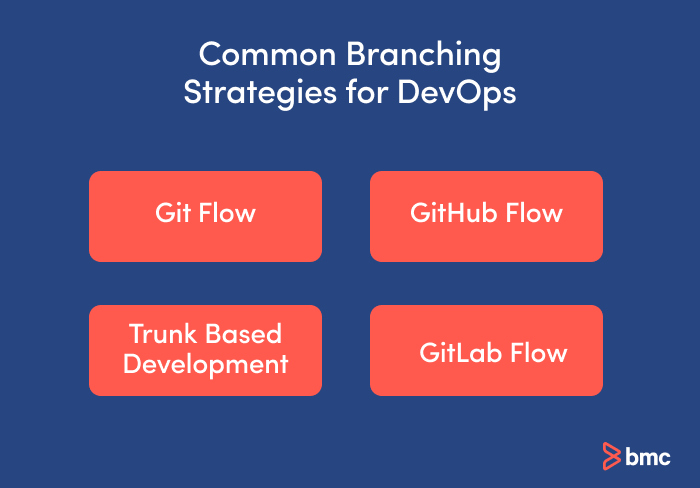
Let’s look at some popular branching strategies currently used in the industry.
Gitflow is the most widely known branching strategy that takes a multi-branch approach to managing source code. This approach consists of two main branches that live throughout the development lifecycle: master and develop.
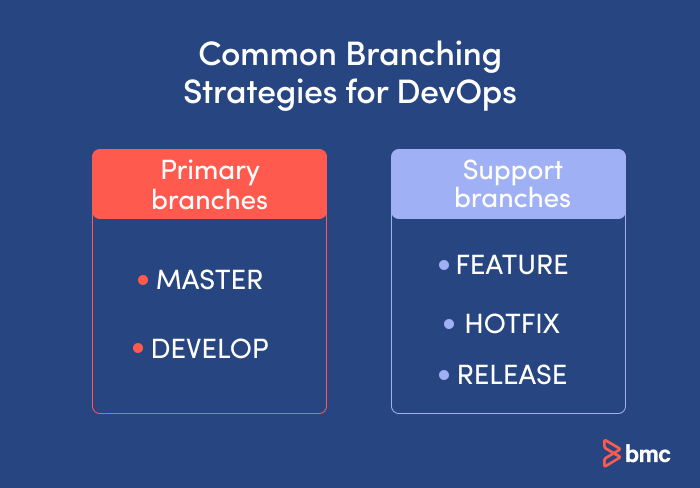
During development, developers create different branches for specific use cases using the “develop” branch as the base. The following are examples of some support branches:
The advantages of the Gitflow branching strategy include:
Despite the pluses, there are some minuses to using the Gitflow branching strategy. These include:
As the name suggests, this strategy was introduced by GitHub, and aims to provide a simple and lightweight approach to manage development. It adheres to the guidelines below when managing the source control with a single primary branch.
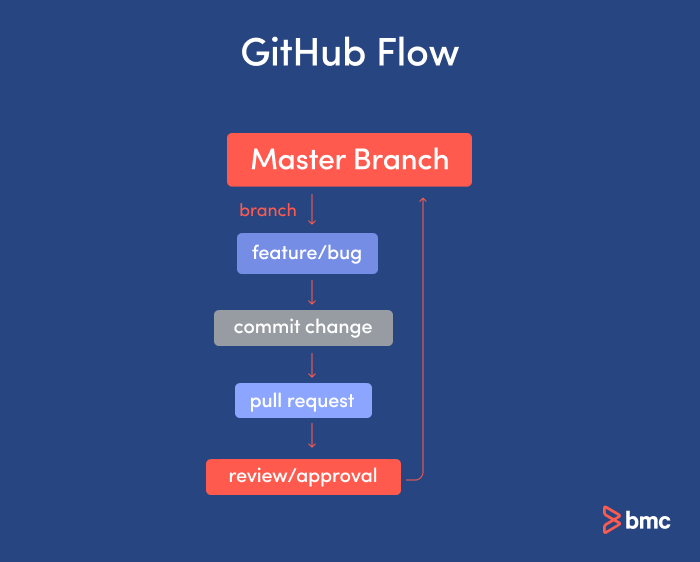
The GitHub Flow branching strategy has the following advantages:
There are disadvantages to using the GitHub Flow branching strategy to consider, as well. These include:
The Trunk-Based Development (TBD) strategy involves developers integrating their changes directly into a shared trunk (master) at least once a day. This shared trunk is always in a releasable state.
Developers can pull from this trunk, create a local repository, and then push the code to the shared trunk. This regular integration enables developers to view each other’s changes quickly and immediately react if there are any conflicts.
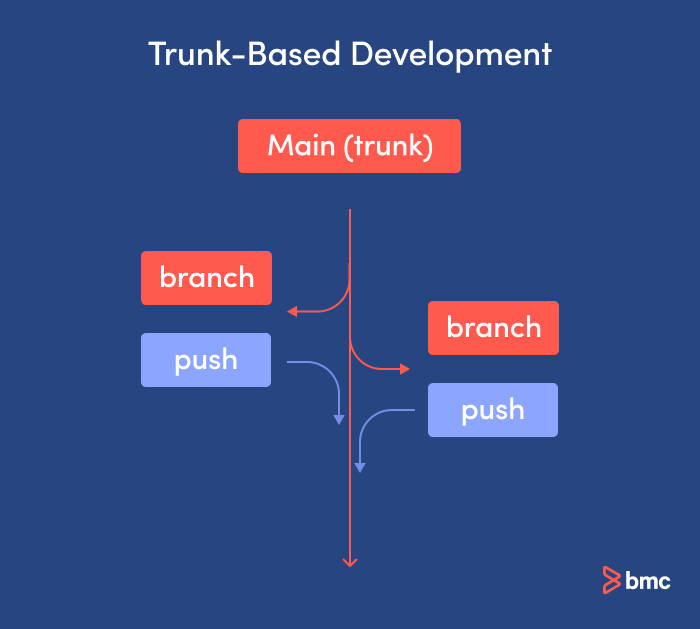
Smaller teams can commit directly to the shared trunk after building and conducting functionality tests. However, for larger teams, development can be broken down into feature/bug fix branches. Developers push code to specific branches continuously, and this code can be verified via pull requests and tested before finally merging into the shared trunk.
This approach enables development teams to both scale seamlessly without overburdening the shared trunk, and maintain all the changes in a more organized and manageable way.
When it comes to deployment, TBD uses feature flags to manage the developments in the shared trunk. Using these feature flags, teams can toggle portions of code on or off for the build process, and deploy only the necessary code in production environments.
The advantages of TBD to consider include the following:
There are a few disadvantages of TBD, such as:
The GitLab strategy combines feature-driven development and feature branches with issue tracking. This strategy is similar to GitHub Flow, yet includes environmental branches such as development, pre-production, and production.
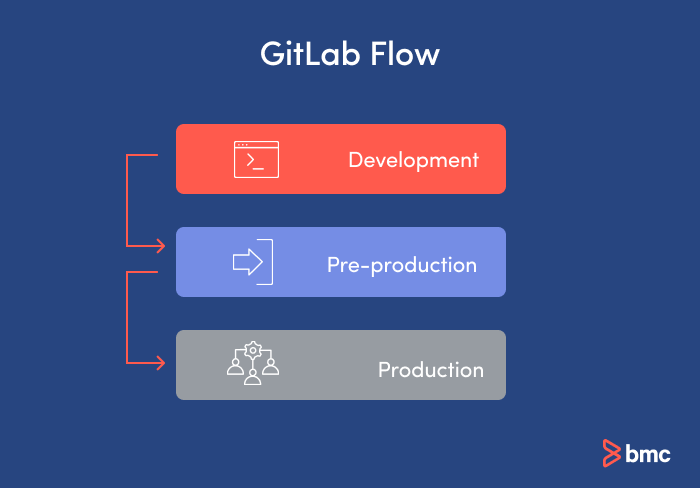 Let’s assume that we have the three environmental branches mentioned above. In that case, the development workflow is:
Let’s assume that we have the three environmental branches mentioned above. In that case, the development workflow is:
The GitLab branching strategy has the following benefits:
The GitLab branching strategy has the following disadvantages:
The branching strategies mentioned above are tried and tested strategies that can be used to manage your source code. However, each has its own strengths and weaknesses.
The traditional Gitflow is not ideal for rapidly evolving DevOps environments. The other strategies described here try to improve Gitflow and modernize it to fit an agile DevOps process. So, as always, you have to select the best strategy that satisfies all your requirements and suits your organizational practices.